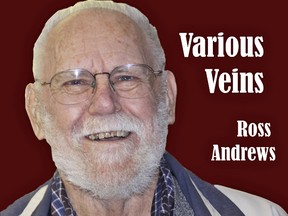Various Veins

Article content
I won't review Theatre Tillsonburg's recent play, Ding Dong Dead, not because it lacked anything. It was simply too complex to discuss without giving away the plot.
I will compliment the actors, especially for delivering their lines clearly enough for this hearing impaired listener to follow them. Great fun!
Son Doug offered me a repair job for a garden ornament. The piece is an old spring tooth scuffler. There are two wooden handles, now broken, for the operator to control the thing. When I was a teenaged farm boy I spent many hours clearing weeds from rows of tobacco with a similar implement.
The horse that pulled this antique must have been a real draught animal. The scuffler would weigh twice what mine did, and the teeth were dainty by comparison. These teeth have been made by a blacksmith wielding a heavy sledge hammer, no doubt sending showers of sparks as the steel was pounded into a soaring curve over the horn of the anvil. The business end was shaped to a point which suggests there would be occasional service to restore the point. All the teeth, five of them, would have to be unbolted and taken to a forge for the work to be done.
My scuffler was fitted with teeth that were secured to the spring by one bolt each. Besides being less time consuming to work on, they were fabricated in different shapes to suit the conditions of soil and weeds. For tobacco, perhaps for corn or other crops, the final round of scuffling was done with a sweep tooth. The two wings spanned the space between rows and just skimmed the ground. Tobacco roots filled the soil between plants and between rows. You didn't want to injure them.
Another difference between the antique and my implement would affect the horse. Mine had a wheel under the front where the handles tapered to meet. This monster has a metal skid that can be adjusted to control the depth of the cultivation. I'll bet old Dobbin had sore shoulders.
My shoulders didn't complain much, but my left wrist was another story. As weeds cling to the teeth the operator has to lift the implement by the handles and give it a shake. Along about ten o'clock in the morning a nerve in that wrist would start to send what felt like an electrical shock from the base of my thumb to where a wrist watch would have been if I'd had one. In those days, us sod busters usually carried a pocket ben watch in a watch pocket. None of my pants have had a watch pocket for ages.
I'm glad I never had to handle anything like this antique! I'll bet every muscle in the driver's body ached.
Since the driver had to keep a hand on each handle, he'd have to tie the reins, either rope or leather, together behind his back tight enough to keep them from falling and hobbling him. A well-trained horse would be guided by the rows of plants. You could correct the nag with a quiet gee to veer right or haw to go left. A horse with an independent streak would need a message to the jaws. You'd have to let go a handle, grab a rein and give it a yank while you tried to hold the implement on an even keep with the other handle.
Cultivating isn't done just to kill weeds. It also affects the moisture in the soil. Hoeing has the same function. Before the roots of the crop grow too long you loosen the earth as deeply as you can. That wicks moisture upwards which encourages roots to spread in search of moisture and nutrients. Dew in the morning air moistens the soil at the surface. When the two actions collide it's a perfect growing condition.
As the roots grew the depth of cultivation was lessened. By the third time around you just broke the crust.
Our share cropper from North Carolina would probe the soil with his fingers and announce, "The moistyah met las' night!"
This knowledge produced a crop that weighed significantly more than a crop on the other side of a fence where the grower just hoed.
OK, back to the job. Where's the gorilla glue?